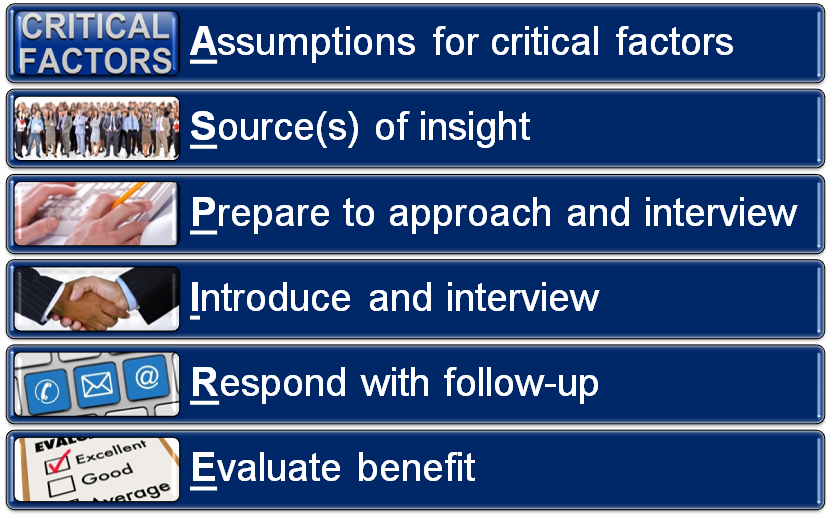6 Steps For Generating More Insights Than Your Competitors

Think of a website, newspaper or magazine you regularly seek out. It might be something as well known as the Wall Street Journal or Financial Times, or much more specialized like MacRumors. Ask yourself why you go to these sources as your “first read.” One reason is they provide unique information before any others. I know this because if there was another source supplying this unique information faster, you’d go there instead. Ask yourself why periodicals such as USA Today, Businessweek and Time Magazine are more likely a “second read” (or “no read”). It’s because they rarely provide an in-depth view on something you haven’t already seen elsewhere.
So when it comes to the research you provide to others, are you a “first read” or “second read”? (Or worse yet, a “no read”?). We developed the ASPIRE™ framework below to help analysts ensure they’re generating the differentiated insights required to be a “first read” to those interested in the stocks they cover.
Analysts following the best practices found in our 6-step ASPIRE™ framework yield more insights critical for stock picking
- Focus on identifying only the key Assumptions that must be answered to forecast the materiality and probability of the 1-4 critical factors for each stock in your universe. I strongly urge not to proceed to the next step unless you’ve created a list of critical factors because it takes substantial time to find and interview the live information sources required to be a first read. All of this effort is a waste of time if the information source doesn’t have insights that help to forecast a critical factor.
- Seek Sources, the less biased the better, that can provide insights about the assumptions required to forecast each critical factor. Here are some of the places to find the names of those with these valuable insights (remember at this point you’re looking for names of individuals, not conducting research itself):
- On-line networking groups such as LinkedIn, alumni networks, etc.
- On-line job boards such as Monster.com and Upwork
- Topical blogs, which can be found using any of the more popular blog searching sites (to find names of the blogger and those who are mentioned or quoted)
- News stories (to find names of the journalist and those being quoted)
- Trade journals focused on your sector(s) for names of high profile professionals
- Industry award winner lists (e.g. “top salesperson of the year”)
- Speakers at conferences (even those you don’t attend) focused on the critical factor(s)
- Authors of papers, books and presentations
- Conduct a Google “Advanced Search” and ensure the “file type” is PDF or PowerPoint
- For books use: http://www.worldcat.org/
- For papers use: http://www.ssrn.com/en/ or http://www.ebscohost.com/ (subscription based)
- You may want to research YouTube, but unless the topic pertains to companies only, you may get too many search results to quickly analyze
- Industry, association and professional society websites
- Databases or lists that contain the names of the largest privately-held companies in your sector (it can be an industry associate directory, or use a service such as Hoovers)
- Search the internet for names of consulting firms that specialize in the sector
- You may want to utilize expert networks (if allowed by your firm), but understand the best contacts are probably already speaking to others in the financial community and so they won’t be proprietary to your efforts
- You’ll want to Prepare before approaching new information sources in order to increase the odds you get the desired information and can go back to them again in the future. The three key elements of preparing include:
- Create questions that will yield insights (discussed in our ICE™ framework)
- Develop tactics to ensure you are prepared to influence the interviewee (discussed in our PRACTICE™ framework)
- Ensure the logistics are conducive for the interview
- Interview with a purpose. If you’ve done the proper preparation, this step becomes much easier. Some of the key elements include:
- Start by building rapport
- Convey confidence while remaining humble
- Qualify the interviewee as quickly as possible, without losing your ability to positively influence
- Focus on one topic at a time
- Don’t allow the interviewee to take control
- End with purpose
- Convey and look for good body language
- Respond with follow-up. Too often analysts don’t follow up with an information source and then three months later when they reach out to the source again, they find no response because the analyst didn’t spend time building rapport or trust at the first exchange. Treat your better information sources as you would a client.
- Evaluate if this information source is valuable enough to warrant valuable cultivation time going forward. If you already have a good list of industry contacts, make sure the ones you spend time cultivating (which can take a lot of time) are actually resulting in good insights regarding the critical factors for your stocks. Spending time with someone deep within a privately-held company may be interesting, but it’s wasted time if it doesn’t help you understand future movement of the publicly-traded company’s stock.
I find when analysts (buy-side or sell-side) are following the ASPIRE™ framework they’re regularly generating unique insights, which makes them a definite “first-read.”
I delve into the ASPIRE™ framework in greater depth, and illustrate best practices to overcome the greatest hurdles, in our workshop Generate Differentiated Insights Through Better Discovery, Questioning, and Influencing.
This Best Practices Bulletin™ targets activity #1, Generate Informed Insights, within our GAMMA PI™ framework.
Visit our new Resource Center to find more helpful articles, reference cards, and advice towards your growth as an Equity Research Analyst.
©AnalystSolutions LLP All rights reserved. James J. Valentine, CFA is author of Best Practices for Equity Research Analysts, founder of AnalystSolutions and was a top-ranked equity research analyst for ten consecutive years

